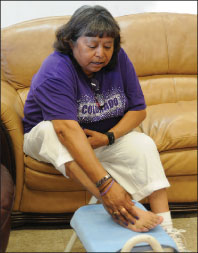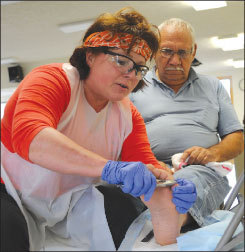Keeping Your Feet Healthy
Keeping Your Feet Healthy
Diabetes Information for You and Your Family
Healthy feet help us to take care of ourselves and our families. We depend on them daily. Many people also use them to walk familiar trails and to take part in traditions, such as dances and ceremonies. For people with diabetes, controlling blood sugars is important to keep feet healthy.
Here are three things you can do to take care of your feet:
Share

Check your feet every day.
Donna Cardoza,
Santo Domingo Pueblo, NM
1. Check your feet every day.
- Look at your feet for cuts, sores, red or swollen areas, and blisters.
- Check for infected or ingrown toenails.
- If you need help checking your feet, use a mirror or ask a family member to help you.
2. Get help if you find a foot problem.
- If you find any problems during your daily foot checks, contact your health care team right away.
- Getting help early can keep small problems from becoming bigger problems.
3. Quit using commercial tobacco or never start.
- Tobacco use reduces blood flow to your feet.
- Ask your health care team about things you can do to quit using commercial tobacco.
- Call 1-800-QUIT-NOW (1-800-784-8669) for free help.
- Avoid being around others who are smoking, including in the car.
At each clinic visit, take off your shoes and socks.

Partner with your health care team.
Mary Schwiderson, RN
Walter LeBlanc,
Bay Mills Tribe, MI
Ask a member of your health care team to:
- Check your feet.
- Show you how to care for your feet.
- Trim your toenails or take care of corns and calluses, if needed.
- Suggest special shoes or inserts to help protect your feet.
What are other ways you can keep your feet healthy?
Wear shoes indoors and outdoors. Do not go barefoot.
- Wear comfortable shoes that fit well and protect your feet.
- Shoes should have round toes and low heels.
- Avoid shoes that are open at either the toe or the heel.
- Before putting your shoes on, check inside each shoe to make sure there are no objects, such as a small rock.
- Wear socks to help prevent getting blisters and sores.
Protect your feet from hot and cold.
- Keep your feet away from heaters, open fires, and heating pads. You may burn your feet and not know it.
- Wear socks at night if your feet get cold.
Wash your feet often.
- Avoid using water that is too hot.
- Dry your feet well, including between your toes.
Put lotion on your feet daily.
- Apply lotion on the tops and bottoms of your feet, but not between your toes.
- Moisture between the toes can make the skin soften and break down, which can lead to infection.
Trim your toenails or ask for help.
- Trim your toenails straight across using toenail clippers.
- Do not use knives or sharp tools to cut the skin close to your toenails, or anywhere else on your feet.
- Ask for help trimming your toenails from a family member or health care team if you:
- Cannot see well.
- Have poor feeling in your feet.
- Cannot reach your feet.
- Have thick toenails.
Report foot problems early.
It is important to get foot problems checked and treated right away. Ask your health care provider about treatment options. They may refer you to a foot or wound care specialist, if needed.


